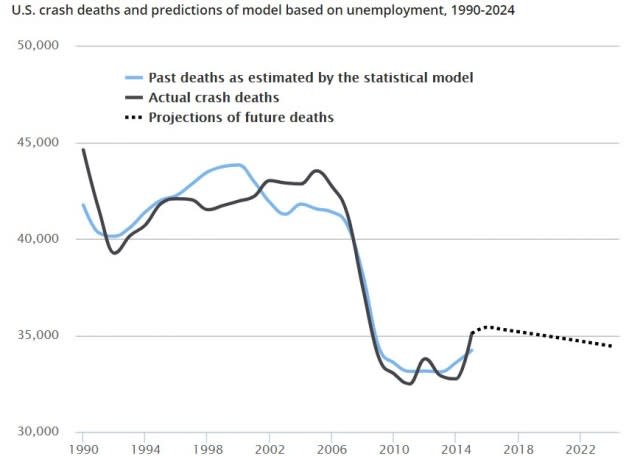The economy's on a roll--and so are highway fatalities

The U.S. economy has come a long way over the past decade, from the highs of the housing bubble to the lows of the Great Recession and slowly, surely back again.
The good news is, America's financial health continues to improve (even though some have begun sounding alarms about another potential "correction").
The bad news is, as the economy has grown over the past couple of years, so have highway fatalities.
Finances and fatalities
The relationship between the economy and roadway deaths isn't always straightforward. For example, years into America's recovery from the recession, fatality rates continued to fall.
In 2015, however, the statistics caught up: as unemployment dropped, deaths of drivers, passengers, and pedestrians surged. Although the National Highway Traffic Safety Administration won't have final figures for 2016 until November or December, early data suggests that the uptick in fatalities continued last year.
The Insurance Institute for Highway Safety suggests that the lag may be attributable to discretionary driving--that is, driving unrelated to our commutes. When people reenter the workforce, most of their travel is related to getting to and from work. Over time, as their financial stability increases, so does their discretionary driving, and that's where accidents can often occur.
The IIHS has crunched some numbers and uncovered some interesting, if gruesome, trends. Its analysts say that every percentage-point drop in unemployment results in a two percent increase in the mileage that Americans put on their vehicles and a four percent increase in the fatality rate.
In sum: every time unemployment dips by one percent, roadway deaths climb by four percent.
(Slightly) better days ahead
Don't think the picture is entirely bleak, though: The IIHS does believe that auto-related fatalities will begin declining this year, and the numbers will improve going forward.
Why? Some of it comes down to the cars that we drive, which are getting safer over time. Although we'll continue to find ourselves involved in collisions on the road, improvements to airbags, crumple zones, and such mean that we're more likely to be injured, not killed.
Also, the IIHS points to the growing popularity of semi-autonomous driving features--features like automatic braking, collision warning, and lane-keeping assist. They help prevent collisions from happening in the first place, further reducing the number of deaths on our nation's roadways. The fully self-driving systems expected in the near future will make driving even saver.
Unfortunately, the gains brought by those technologies will be undercut by America's strengthening economy and, less excitingly, our increasingly strained infrastructure. Translation: expect a drop in fatality figures, but don't expect the improvements to be dramatic just yet.
The U.S. economy has come a long way over the past decade, from the highs of the housing bubble to the lows of the Great Recession and slowly, surely back again.
The good news is, America's financial health continues to improve (even though some have begun sounding alarms about another potential "correction").
The bad news is, as the economy has grown over the past couple of years, so have highway fatalities.
Finances and fatalities
The relationship between the economy and roadway deaths isn't always straightforward. For example, years into America's recovery from the recession, fatality rates continued to fall.
In 2015, however, the statistics caught up: as unemployment dropped, deaths of drivers, passengers, and pedestrians surged. Although the National Highway Traffic Safety Administration won't have final figures for 2016 until November or December, early data suggests that the uptick in fatalities continued last year.
The Insurance Institute for Highway Safety suggests that the lag may be attributable to discretionary driving--that is, driving unrelated to our commutes. When people reenter the workforce, most of their travel is related to getting to and from work. Over time, as their financial stability increases, so does their discretionary driving, and that's where accidents can often occur.
The IIHS has crunched some numbers and uncovered some interesting, if gruesome, trends. Its analysts say that every percentage-point drop in unemployment results in a two percent increase in the mileage that Americans put on their vehicles and a four percent increase in the fatality rate.
In sum: every time unemployment dips by one percent, roadway deaths climb by four percent.
(Slightly) better days ahead
Don't think the picture is entirely bleak, though: The IIHS does believe that auto-related fatalities will begin declining this year, and the numbers will improve going forward.
Why? Some of it comes down to the cars that we drive, which are getting safer over time. Although we'll continue to find ourselves involved in collisions on the road, improvements to airbags, crumple zones, and such mean that we're more likely to be injured, not killed.
Also, the IIHS points to the growing popularity of semi-autonomous driving features--features like automatic braking, collision warning, and lane-keeping assist. They help prevent collisions from happening in the first place, further reducing the number of deaths on our nation's roadways. The fully self-driving systems expected in the near future will make driving even saver.
Unfortunately, the gains brought by those technologies will be undercut by America's strengthening economy and, less excitingly, our increasingly strained infrastructure. Translation: expect a drop in fatality figures, but don't expect the improvements to be dramatic just yet.

 Yahoo Autos
Yahoo Autos 